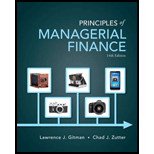
Concept explainers
Calculation of individual costs and WACC Lang Enterprises is interested in measuring its overall cost of capital. Current investigation has gathered the following data. The firm is in the 40% tax bracket. Debt The firm can raise debt by selling $1,000-par-value, 8% coupon interest rate, 20-year bonds on which annual interest payments will be made. To sell the issue, an average discount of $30 per bond would have to be given. The firm also must pay flotation costs of $30 per bond.
Common stock The firm’s common stock is currently selling for $90 per share. The firm expects to pay cash dividends of $7 per share next year. The firm's dividends have been growing at an annual rate of 6%, and this growth is expected to continue into the future. The stock must be underpriced by $7 per share, and flotation costs are expected to amount to $5 per share. The firm can sell new common stock under these terms.
- a. Calculate the after-tax cost of debt.
- b. Calculate the cost of preferred stock.
- c. Calculate the cost of common stock.
- d. Calculate the firm’s WACC using the capital structure weights shown in the following table. (Round answer to the nearest 0.1%.)
| Source of capital | Weight |
| Long-term debt | 30% |
| Preferred stock | 20 |
| Common stock equity | 50 |
| Total | 100% |
Want to see the full answer?
Check out a sample textbook solution
Chapter 9 Solutions
Principles of Managerial Finance (14th Edition) (Pearson Series in Finance)
 EBK CONTEMPORARY FINANCIAL MANAGEMENTFinanceISBN:9781337514835Author:MOYERPublisher:CENGAGE LEARNING - CONSIGNMENT
EBK CONTEMPORARY FINANCIAL MANAGEMENTFinanceISBN:9781337514835Author:MOYERPublisher:CENGAGE LEARNING - CONSIGNMENT Intermediate Financial Management (MindTap Course...FinanceISBN:9781337395083Author:Eugene F. Brigham, Phillip R. DavesPublisher:Cengage Learning
Intermediate Financial Management (MindTap Course...FinanceISBN:9781337395083Author:Eugene F. Brigham, Phillip R. DavesPublisher:Cengage Learning Cornerstones of Financial AccountingAccountingISBN:9781337690881Author:Jay Rich, Jeff JonesPublisher:Cengage Learning
Cornerstones of Financial AccountingAccountingISBN:9781337690881Author:Jay Rich, Jeff JonesPublisher:Cengage Learning Managerial Accounting: The Cornerstone of Busines...AccountingISBN:9781337115773Author:Maryanne M. Mowen, Don R. Hansen, Dan L. HeitgerPublisher:Cengage Learning
Managerial Accounting: The Cornerstone of Busines...AccountingISBN:9781337115773Author:Maryanne M. Mowen, Don R. Hansen, Dan L. HeitgerPublisher:Cengage Learning





